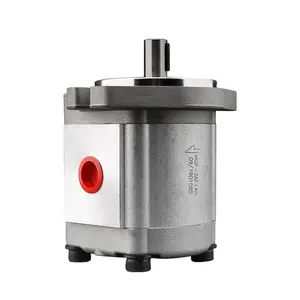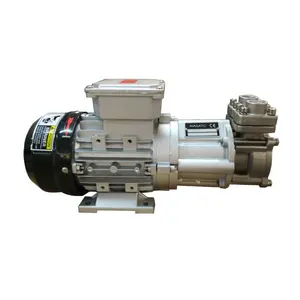(79919 products available)












































































































































































There are various types of small oil pumps, each having its own advantages. Here are some of them:
Gear small oil pump
Small gear oil pumps use two interlocking gears to move liquids. As the gears turn, they create a flow by trapping liquid in the spaces between the gears and the pump housing, then discharging it at the pump's outlet. This pumping action is made possible by the precise clearance between the gears and the housing, as well as the gearing and rotating motion. Gear oil pumps are widely used due to their reliability and ability to handle viscous liquids.
Peristaltic small oil pump
A peristaltic small oil pump is a type of positive displacement pump that use one or more rotating rollers that compress a flexible tube. This action mimics the natural muscular contractions of peristalsis that moves fluids through the digestive tract. The rollers sequentially press on the tube, creating a decreasing volume that forces the fluid inside the tube to move. As the rollers pass, the tube recovers, and the fluid is drawn back, ready for the next cycle. This unique mechanism allows for precise flow control and makes it suitable for applications requiring sterile or contamination-free fluid transfer.
Diaphragm small oil pump
A diaphragm small oil pump is a type of positive displacement pump that uses the reciprocating motion of a diaphragm to convey fluids. The diaphragm is alternately pulled and pushed by a prime mover, such as an electric motor or an air piston, via a mechanical actuation system. This cycling creates alternating chambers of compression and expansion, driving the fluid through the pump. The mechanical actuation system translates the prime mover's motion into precise diaphragm movement, enabling accurate fluid transfer. Diaphragm small oil pumps are widely used in various industries due to their reliability and ability to handle diverse fluid characteristics.
Rotary lobe small oil pump
Small rotary lobe oil pumps are positive displacement pumps that use two lobes rotating in parallel but in opposite directions. The synchronized rotation of the lobes creates an intermittent flow pattern, forming chambers of expansion and contraction. This unique mechanism allows for the gentle and precise transfer of fluids. As the lobes rotate, the changing volume in the pump casing draws the fluid in, and the lobes' movement displaces it toward the pump's outlet. This action results in a smooth and controlled flow, making rotary lobe oil pumps suitable for applications where maintaining the integrity of the conveyed fluids is essential.
The specifications of a small oil pump are determined by the needs of the intended application. Below are some of the common specifications found in the different models:
Flow Rate
The flow rate is the amount of oil that is pumped in a minute. The flow rate can be as low as 1 liter per minute and go as high as 50 liters per minute or more. The flow rate determines the type of application that the pump can be used for.
Maximum Pressure
Some small oil pumps can generate a lot of pressure, which enables them to pump oil through long pipes. The maximum pressure that is generated by the pump can be 5 bars or even higher, going up to 30 bars. The pressure of the pump is determined by the design and the motor power.
Power Supply
Small oil pumps are powered by electric motors. The motor can be powered by a 12-volt battery or a 240-volt power supply. The power supply affects the flow rate and the maximum pressure of the pump.
Viscosity
Most small oil pumps are designed to pump oil with a low viscosity. The viscosity of the oil is indicated on the pump. The oil viscosity that is pumped can range from 10 centistokes (cSt) to 100 cSt.
Pump Material
Small oil pumps are made from different materials. The material that is used depends on the type of oil that is being pumped. Common materials include aluminum, stainless steel, and plastic. Each material has its own advantages, such as resistance to corrosion and durability.
Below are some maintenance practices that are done to ensure that the small oil pump is in good working condition:
There are several factors to consider when choosing a suitable small oil pump for a given application. These include the following:
Oil type
The type of oil being pumped is an important consideration when selecting a small oil pump. Different types of oil have different viscosities and flow characteristics. For instance, a small oil pump intended for use with motor oil should have a different design than one intended for use with hydraulic oil or gear oil. Hydraulic oils, for example, have a higher viscosity compared to motor oils.
Viscosity
The viscosity of the oil is a key factor when choosing a small oil pump. Viscosity affects the flow rate and the resistance to pumping. Thicker oils require more powerful pumps to move them through the system. As such, buyers should consider the viscosity of the oil being used when selecting a small oil pump.
Flow rate requirements
Flow rate is one of the most important specifications of an oil pump. Different applications have different flow rate requirements. Buyers should select a pump with a flow rate that meets the demands of the specific application. Besides, the flow rate of the pump should be compatible with the requirements of the system to ensure efficient operation.
Pressure requirements
Buyers should consider the pressure requirements of the application when choosing a small oil pump. Some applications may require higher pressure to overcome friction losses in long pipelines or to deliver oil to elevated locations. In such cases, a small high-pressure oil pump would be necessary.
Pumping distance and elevation
The distance and elevation that oil needs to be pumped are important considerations when selecting a small oil pump. Longer distances and higher elevations require more powerful pumps to overcome the resistance to flow. Buyers should consider the pumping distance and elevation when selecting a small oil pump with sufficient power.
Oil quality
The quality of the oil being pumped is also a consideration when selecting a suitable small oil pump. If the oil contains additives or particles, buyers should choose a pump that can handle these components without causing damage or degradation to the oil.
Environmental conditions
Environmental conditions such as temperature and humidity can affect the performance of small oil pumps. Buyers should select a pump that is suitable for the environmental conditions of the specific application location.
Application
Different applications require different types of oil pumps. For instance, a pump used in an automatic lubrication system would have different specifications than one used in a hydraulic power unit. Buyers should select a small oil pump that is designed for the specific requirements of the intended application to ensure reliable and efficient operation.
Preparation
Before anything else, get the right tools for the task at hand. These should include wrenches, sockets, oil basins, screwdrivers, and perhaps a pump puller. To avoid any electrical accidents, disconnect the battery. Have the new small oil pump ready for installation.
Access the oil pump
It is important to first read the manufacturer's manual and locate the oil pump in the engine. Its position is often common in the lower part of the engine near the oil pan. After that, remove any components or covers that may be obstructing access to the pump.
Drain the oil
Drain the oil from the small oil reservoir using the oil drain pan. To avoid messes, be sure to follow the proper procedure for oil disposal as stipulated by local regulations.
Remove the old pump
Remove the pump’s mounting bolts using a wrench or ratchet. It may be difficult to do this if the bolts are rusted or if there is limited space. In such a case, an oil pump puller may come in handy. Disconnect any electrical connections or sensors related to the pump. Carefully remove the pump from its location. Be cautious of any residual oil that may spill during this process.
Install the new pump
Put the new small oil pump in the cleaned area. After that, tighten the bolts and make sure they are secure but do not overtighten them. Reconnect any electrical connections or sensors that were previously disconnected. Double-check all connections to ensure everything is properly fitted.
Reassemble and refill
Replace any removed components or covers in their respective positions. Ensure everything is aligned correctly and securely fastened. Reconnect the battery and ensure all connections are clean and tight. Refill the engine with fresh oil through the oil fill cap, following the manufacturer's recommendations for the type and quantity of oil. Start the engine and allow it to run for a few minutes. This ensures proper oil circulation and pump priming. Check for any leaks around the pump and connections. If any leaks are detected, tighten the fittings or address any issues accordingly.
Q1: What is the purpose of a small oil pump?
A1: Small oil pumps are used to transfer oil from one place to another. The oil can be non-combustible, edible, or industrial.
Q2: Where is a small oil pump used?
A2: A small oil pump is used in many applications, including oil transfer operations, lubrication systems, cooking oil applications, and chemical processes.
Q3: What is the flow rate of a small oil pump?
A small oil pump has a small flow rate, which can be between 0.5 and 30 m3/h, depending on the type and application.